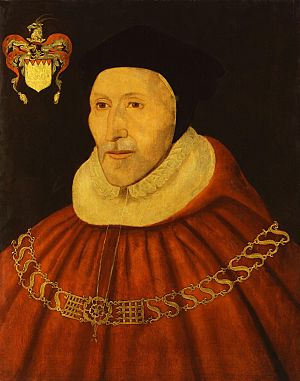James Dyer facts for kids
Quick facts for kids
Sir James Dyer
|
|
|---|---|

Sir James Dyer, 1575. National Portrait Gallery, London.
|
|
| Speaker of the House of Commons | |
| In office 1553–1553 |
|
| Monarch | Edward VI of England |
| Preceded by | Sir John Baker |
| Succeeded by | Sir John Pollard |
| Chief Justice of the Common Pleas | |
| In office 1559–1582 |
|
| Preceded by | Sir Anthony Browne |
| Succeeded by | Sir Edmund Anderson |
| Personal details | |
| Born | 1510 |
| Died | 24 March 1582 |
| Spouse | Margaret à Barrow |
Sir James Dyer (born 1510 – died 24 March 1582) was an important English judge. He also served as the Speaker of the House of Commons for a short time. Later, he became the Chief Justice of the Common Pleas, a very high legal position. He is remembered for changing how legal cases were recorded.
Contents
Sir James Dyer's Life and Career
Sir James Dyer began his journey in law around the 1520s. He studied at places like Strand Inn and the Middle Temple. By 1537, he was likely working as a lawyer.
In 1552, he became a serjeant-at-law. This was a special type of senior lawyer. The next year, in 1553, he was made a knight by the King.
Serving in Parliament
Sir James Dyer was elected as a Member of Parliament (MP) several times. He represented the town of Wells in Somerset. He also represented Cambridgeshire.
In 1553, he was chosen to be the Speaker of the House of Commons. This meant he was in charge of leading discussions in Parliament.
A Top Judge
Sir James became a judge in the Court of Common Pleas in 1557. This court dealt with common legal disputes between people.
In January 1559, he was promoted to Chief Justice of the Common Pleas. This was one of the most powerful legal jobs in England. He held this important role until he died in 1582.
Changing How Laws Were Recorded
Sir James Dyer is famous for being the first "law reporter." He created a new way to record legal cases. This system helped future judges understand past decisions.
Before him, legal cases were written in "yearbooks." These were not meant to be used as examples for new cases. Dyer's work changed this. His detailed reports helped create the idea of legal precedent. This means that past court decisions can guide future ones.
His reports were first written in an old French language. Later, they were translated into English. His work covered cases from 1513 to 1582.
His Legacy
Sir James Dyer was known for his deep knowledge of the law. People respected his fair judgments and honesty. He was also generous and helped other lawyers.
His detailed notes, which he wrote himself, show how careful he was. He was seen as a wise and respected person in the legal world.
His brother's grandson, Sir Richard Dyer, became his heir.

